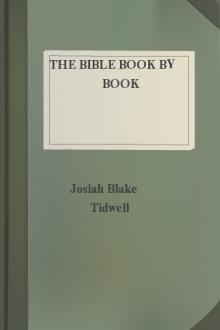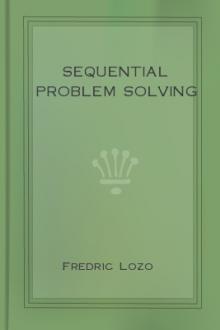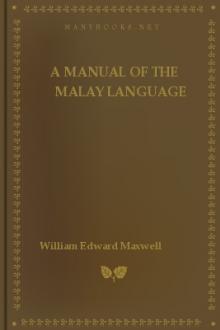The Bible Book by Book by Josiah Blake Tidwell (best short books to read .txt) 📕

- Author: Josiah Blake Tidwell
- Performer: -
Book online «The Bible Book by Book by Josiah Blake Tidwell (best short books to read .txt) 📕». Author Josiah Blake Tidwell
II. What Those who Live such Lives may Know, 5:13-20.
1. That they have eternal life. 13.
2. That their prayers are answered, 14-17.
3. That God's people do not live in sin, 18.
4. Their true relation to God and to Christ, 19-20.
Conclusion, 5:21.
The following analysis made with the idea of the theme being "Fellowship with God" (1:3-4) is very suggestive.
Introduction, 1:1-4.
I. God is Light and our fellowship with him depends upon our walking in the light, 1:5-2:28.
II. God la Righteous and our fellowship with him depends upon our doing righteousness, 2-29, 4:6.
III. God is Love and our fellowship with him depends upon our having and manifesting a spirit of love, 4:7-5:3.
IV. God Is Faithful and our fellowship with him depends upon our exercising faith in him, 5:4-12.
Conclusion. 5:13-21 end.
For Study and Discussion. (1) The different things we may know and how we may know them. Make a list giving reference, as, "know Him if we keep His commandments" (2:3). (2) Make a list of the things defined in the following scriptures, and give the definition in each case: 1:5; 2:25; 3:11, 3:23; 5:3; 5:4; 5:11; 5:14. (3) The several figures and attributes of God, as light, righteousness and love. (4) The requirements of deeds of righteousness, 1:6, 7; 2:9-11; 3:17-23. (5) God's love for his children, 3:1-2; 4:8-11, 16, 19. (6) Christians' duty to love one another, 2:10; 3:10-24; 4:7-21; 5:1-2. (7) The propitiatory death of Jesus Christ, 1:7; 2:1-2; 4:10. (8) Difference between Christians and non-Christians, 3:4-10. How many times do each of the following words occur? Love, light, life, know, darkness, hate, righteousness, sin, liar and lie, true and truth.
Second John.
It is a friendly, personal letter, written some time after the first letter, to the "elect lady" who, as I think, was John's friend, and not a church or some nation as has sometimes been argued. The aim is evidently to warn his friend against certain false teachers.
Analysis.
1. Greeting, 1-3.
2. Thanksgiving, 4.
3. Exhortation to obedience. 5-6.
4. Warning against anti-Christs, 7-9.
5. How to deal with false teachers, 10-11.
6. Conclusion, 12-13.
For Study and Discussion. (1) The character of the children of the elect lady. (2) Evidence of real discipleship. (3) How to deal with false teachers.
Third John.
This also is a private letter written, some time after First John, to his personal friend, Gaius. There was some confusion about receiving certain evangelists. Gaius had received them while Diotrephes had opposed their reception. He commends Gaius for his Christian hospitality and character.
Analysis.
1. Greeting, 1.
2. Prayer for his posterity, 2.
3. Commends his godly walk, 3-4.
4. Commends his hospitality, 5-8.
5. Complaint against Diotrephes, 9-10.
6. Test of relation to God, and worth of Demetrius, 11-12.
7. Conclusion, 13-14.
For Study and Discussion. (1) The character of Gaius and Diotrephes. (2) Christian hospitality. (3) Such words as truth, sincerity and reality.
Jude.
The author is named as Jude, the brother of James. He probably means the James wrote the epistle of that name and is, therefore, the Lord's brother.
Purpose. False teachers were boldly teaching their heresies in the meetings of the congregation. These men were also very immoral in conduct and the epistle is written to expose their errors and to exhort his readers to contend for the true faith and to live worthy lives. In many points it is very similar to the second letter of Peter.
Date. It was probably written about A. D. 66. At any rate it must have been written before A. D. 70 when Jerusalem was destroyed, as Jude would hardly have failed to mention that event along with other examples of punishment, 5-7.
Analysis.
Introduction, 1-4.
I. The Fate of Wicked Disturbers, 5-16.
1. God punishes the wicked, 5-7.
2. He will destroy these men, 8-16.
II. How to Contend For the Faith, 17-23.
1. Be mindful of the enemies, 17-19.
2. Be strong (built up in the faith), 20-21.
3. Maintain an evangelistic spirit, 22-23.
Conclusion, 24-25.
For Study and Discussion. (1) Make a list of all the words and phrases occurring in threes, as mercy, love, peace, or Cain, Baalam, Korah. (2) Make a list of all the different things taught about the evil workers mentioned, 8-10, 12, 13. 16, 19. (3) What the apostles had foretold concerning them.
Revelation.
Author. John, the Apostle, while in exile on the Isle of Patmos, 1:1, 4, 9; 22:8.
Date. About 95 or 96 A. D.
The Book. (1) It is a book of symbols and imagery, and constantly creates excitement and wonder. (2) It is a book of wars, but war always ends in peace. The word war occurs seven times in Revelation, and only seven times in all the rest of the New Testament. (3) It is a book of thunder, but the thunder and earthquake die away and are followed by liturgies and psalms. (4) It is a book of the rewards of the righteous. This is seen in the letters to the seven churches, and in the victories of the right in all conflicts and wars of the book. (5) It is, therefore, a book of optimism. Everywhere God overcomes Satan, the Lamb triumphs, Babylon falls, etc.
Its Interpretation. There are several classes of interpreters, as follows (1) The Praeterist, who thinks it has been fulfilled in its primary sense. He makes all the prophesies and visions refer to Jewish history down to the fall of Jerusalem, and to the history of Pagan Rome. (2) The Futurist, who interprets literally and thinks all the events of the book are to come just before or just after the second coming of Christ. (3) The Historical or Continuous School. These think some have been fulfilled, some are now being fulfilled, and some will be fulfilled in the future. (4) The Spiritualist, who objects to the other three classes of interpreters because they make so much of the time element. He lays stress upon the moral and spiritual element of the book and reads the book "as a representation of ideas rather than of events."
Value. The chief value of the book seems to lie in its testimony to the faith and hope of persecuted Christians and in the comfort and inspiration it has brought to sorrowing and oppressed souls of every age. It points outthat there will be an end of conflict, that God and the Lamb will triumph that the enemies of our souls will be punished and that the followers of God will be rewarded with eternal reward.
Analysis.
Introduction, 1-8.
I. The Seven Churches, 1:9-3 end.
1. A preparatory vision of Christ, 1:9 end.
2. The addresses to the churches, Chs. 2-3.
II. The Seven Seals, 4:1-8:1.
1. A preparatory vision of the throne, Chs. 4-5.
2. Six seals opened in order, Ch. 6.
3. An episode-sealing God's servants, Ch, 7.
4. The seventh seal opened, 8:1.
III. The Seven Trumpets, 8:1l end.
1. A preparatory vision, 8:2-6.
2. Six trumpets sounded in order, 8:7-9 end.
3. An episode-Little book, measuring the temple and two witnesses, 10:1-11:14
4. The seventh trumpet sounded, 11:15 end.
IV. The Seven Mystic Figures. Chs. 12-14.
1. The sun-clothed woman, Ch. 12.
2. The red dragon, Ch, 12.
3. The man-child, Ch. 12.
4. The beast from the sea, 13:1-10.
5. The beast from the earth, 13:11-18.
6. The Lamb on Mount Sion, 14:1-13. Three angels.
7. The son of man on the cloud, 14:14-20. Three angels.
V. The Seven Vials, Chs. 15-16.
1. The preliminary vision, Ch. 15-a song of victory.
2. Six vials poured out in order, 16:1-12.
3. An episode, 16:13-16. The spirits of the devil gather the kings of the earth to the battle of Armageddon.
4. The seventh vial poured out, 16:17-21 (end).
VI. Three Final Conflicts and Triumphs, 17:1-22:5.
1. The first conflict and triumph, 17:1-19:10.
2. The second conflict and triumph, 19:11-20:6.
3. The third conflict and triumph, 20:7-22:5.
VII. The Epilogue Conclusion, 22:6-21 end.
1. Three-fold testimony to the truth of the vision. Angel, Jesus. John, 6-8.
2. Directions of the angels concerning the prophecy, 9-10.
3. The moral of the book, 11-17.
4. John's attestation and salutation, 18-21.
For Study and Discussion. (1) The vision of Jesus, 1:9 end. (2) The letters to the seven churches: (a) Which churches are given noting but praise? (b) Which nothing but blame? (c) Which both praise and blame? (d) What is commended and what condemned in each. (3) The twenty-four elders, four living creatures, sealed book and the Lamb, Chs. 4-5. (4) The sealing of God's servants, Ch. 7. (5) The little book, Ch. 10. (6) The measuring rod and two witnesses; 11:1-14. (7) Each of the seven mystic figures, Chs. 12-14. Describe each. (8) Mystery Babylon, Ch. 17. (9) Song of triumph over Babylon, 19:1-10. (10) The judgment of Satan, 20:1-10. (11) The description of the general resurrection and judgment, 20:11-15; 22:10-15. (12) The description of heaven, Chs. 21-22. (13) Verify the following points of similarity in the seven seals, seven trumpets and seven vials, (a) that heaven is opened and a preliminary vision before each series, (b) that the first four in each series refer especially to the present natural world, while the last three in each series refer more particularly to the future or spiritual world, (c) that in each series there is an episode after the sixth which is either an elaboration of the sixth or an introduction to the seventh. (14) Compare these three series again and note, (a) that they portray the same events in similar language, (b) that the victory of the righteous and the destruction of the wicked are portrayed in each, (c) that the victory of the redeemed predominates in the first (seals) while the destruction of the wicked predominates in the last (vials). (15) In the series note the progress in the severity of punishment, (a) one- fourth afflicted in the first (seals), (b) one-third afflicted in the second (trumpets), (c) all are destroyed in the third (vials). (16) From the following scriptures make a list allowing how nearly the same thing is affected in each of the seven trumpets and vials, (a) 8:7 and 16:2, (b) 8:8 and 16:3, (c) 8:10-11 and 16:4-7, (d) 8:12 and 16:8-9, (e) 9:9-11 and 16:10-11, (f) 9:13-21 and 16:12-16, (g) 11:15-18 and 16:17-21. (17) The contrasts and resemblances of the trumpets and vials.
Trumpets. 1. Hail, fire blood cast on earth, one-third of the trees burned.
Vails. 1. The Vial poured out on the earth, affliction upon the followers of the beast.
Trumpets. 2. One-third of the sea made blood, one-third of its creatures and of its ships destroyed.
Vails. 2. The whole sea made blood, and every soul therein destroyed.
Trumpets. 3. One-third of the rivers made bitter, many men destroyed.
Vials. 3. All the rivers made blood and vengeance upon all men.
Trumpets. 4. One-third of the sun, etc., smitten, one-third of the day darkened.
Vials. 4. The whole sun smitten, men are scorched, they blaspheme and repent not.
Trumpets. 5. The stars of heaven fall into the pit; locusts sent forth; men seek death.
Vials. 5. The throne and kingdom of the beast smitten, men suffer and blaspheme and repent not.
Trumpets. 6. One-third of the men destroyed by the armies of the Euphrates; men do not repent. Episode: God's two witnesses witness for Him and work miracles. War against them by the beasts.
Vials. 6. A way prepared for the kings beyond the Euphrates. Episode: The dragon's three unclean spirits witness for him and work miracles. War by the world at Armageddon.
Trumpets. 7. Voices in heaven, judgment, earthquake, hail, etc.
Vials. 7, Voice in heaven, fall of Babylon, earthquake, hail, etc.
(18) The benedictions and doxologies of the book. (19) Things taught about Jesus. (20) Things taught about Satan.
END.
End of Project Gutenberg's The Bible Book by Book, by Josiah Blake Tidwell
*** END OF THIS PROJECT GUTENBERG EBOOK THE BIBLE BOOK BY BOOK ***
***** This file should be named 16290-h.htm or 16290-h.zip *****
This and all associated files of various formats will be found in:
http://www.gutenberg.org/1/6/2/9/16290/
Produced by Fredric Lozo
Updated editions will replace the previous one--the old editions
will be renamed.
Creating the works from public domain print editions means that no
one owns a United States copyright in these works, so the Foundation
(and you!) can copy and distribute it in the United States without
permission and without paying copyright royalties. Special rules,
set forth in the General Terms





Comments (0)